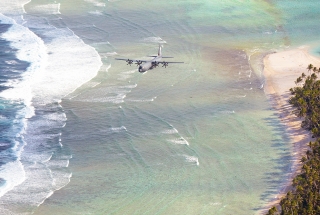Australia can’t forget Micronesia

Picture by the US Air Force
Australia’s decision to open new diplomatic posts in Palau and the Marshall Islands should be the first of many steps in an increased diplomatic footprint in Micronesia.
There’s been a veritable blizzard of new and significant announcements as part of the Morrison government’s step up in our Pacific engagement. We’ve seen the Australian government commit to establish an Australian Infrastructure Financing Facility for the region and an extra $1 billion in callable capital to EFIC, Australia’s export financing agency.
Canberra and Port Moresby have agreed to establish a joint naval base at Manus Island in PNG, with the US to be a partner – a move I’d suggested earlier this year.
We’ve recently offered to lead an attempt to bring electricity to 70 per cent of Papua New Guineans by 2030. The Department of Foreign Affairs will establish a new Office of the Pacific to coordinate a whole-of-government response to closer ties with Pacific governments and regional organisations.
But in the battery of these and other government Pacific ‘announceables’, one has flown under the radar.
On 8 November, Prime Minister Scott Morrison promised that we’d open new diplomatic missions in French Polynesia, Niue and the Cook Islands. But importantly, he also flagged that we’ll open two new diplomatic posts in the North Pacific: one in Palau (population 22,000) and a new post in the Marshall Islands (population 53,000).
Even if most people couldn’t locate these two places on a map, the government’s commitment to new North Pacific posts is a long overdue step, as our diplomatic footprint in Micronesia is tiny.
Our Pohnpei ambassador has multiple accreditations: to the Federated States of Micronesia (FSM), the Marshall Islands and Palau, and (as Consul-General) to Guam and the Commonwealth of the Northern Mariana Islands. This contrasts with Japan, which maintains diplomatic missions in the FSM, the Marshall Islands and Palau, as well as consulates in Guam and Saipan in the Northern Mariana Islands.
We’ve got no Defence advisor based in Micronesia, although there are several naval surveillance advisors linked to Australian-donated Pacific patrol boats. In April this year, Palau, the Marshall Islands and the FSM signed an agreement establishing the Micronesian Regional Transnational Crime Unit. It’s linked to the Australian Federal Police’s Transnational Crime Coordination Centre located in Apia, Samoa. But there’s no AFP presence in the North Pacific, a hub for transnational crime.
Micronesia has been used in the past as an invasion route to Papua New Guinea and an attack route to Australia. It’s an important strategic axis where the interests of China, Japan, Taiwan and the US, as well as several Southeast Asian countries, intersect. The US military’s Kwajalein base is used as a test site for ballistic missiles launched from the US as well as other missile and space-related activities, and is on a long-term lease arrangement with the Marshall Islands.
Five of the 16 independent and self-governing states of the Pacific’s main political grouping, the Pacific Islands Forum, are Micronesian. Guam and the Northern Marianas are associate members of the Forum.
Under the terms of ‘Compacts of Free Association’ with Palau, FSM and the Marshall Islands, the US has defence responsibilities for each. US grants account for about 60 per cent of government budgets in these Pacific nations. But substantial US direct subsidies are due to end in 2023, when a US-managed sovereign trust fund for each is meant to underpin further development.
The centrepiece of US-led North Pacific security is Guam. It’s becoming like Hawaii was before World War II: a mixture of holiday destination and military base, but with the military infrastructure becoming bigger and bigger.
There are already large numbers of Japanese, Korean and potentially huge numbers of Chinese tourists going to the island. Guam’s geography and American sovereignty allow it to serve as a major logistics base for forward-deployed US aircraft and ships in the western Pacific.
At the same time, China’s been lifting its commercial presence in Guam, the Northern Marianas, Palau, FSM and the Marshall Islands. In Saipan, for example, there’s a Chinese casino company and another wants to build a casino in neighbouring Tinian, where two-thirds of the island is leased to the US military.
China’s also been very active on the commercial side in Guam, installing underwater listening devices in locations near the island. Chinese tourists have flooded into Palau, although there’s some evidence of China ‘weaponising’ tourists to Palau because it recognises Taiwan.
One analyst has observed that:
China has taken a steady, systematic approach over the last 30 years, insinuating itself into Micronesia’s political and commercial worlds and society via schemes of grants, loans, donations, gifts, scholarships and training courses, friendship associations, and including the Micronesian states in China-sponsored regional forums, dangling the lures of investment and aid.
Establishing Australian embassies in Palau and the Marshall Islands should lead us to consider possible plans in preparation for the transfer of about 4,000 of 19,000 marines stationed in Okinawa to Guam from 2024 to 2028.
While Australia contributes to security in the region through participation in the high-end air combat and humanitarian assistance exercise Cope North, we should consider Australian defence representation on Guam and training with the US there and other areas of Micronesia.
Guam is becoming more strategically important for Japan as a military training area. Many of Japan’s mainland military bases are near residential areas, fisheries and crowded airspace. This places restrictions on Japanese training capabilities.
Guam offers less constrained waters, airspace and bombing ranges for the air forces of Thailand, Singapore and South Korea.
In the case of a contemporary conflict in East Asia, US forces in Japan would take action. But backup forces in Guam would provide support to places such as the South China Sea and Taiwan, with shorter flying and sailing times than forces based in Hawaii or the US west coast.
If we’re going to be operating air and naval forces out of Manus Island, then having access to Guam and some of the other Micronesia states would be useful, even if only for logistics.
We should build on our greater diplomatic footprint in the North Pacific and establish a consulate in Guam, with an Australian senior defence or foreign affairs liaison officer.
It will always make good strategic sense for Australia to focus our South Pacific efforts on Melanesia. But Micronesia’s strategic significance is rising. We should be working with our North Pacific neighbours.
This article originally appeared in policyforum.net
Source











